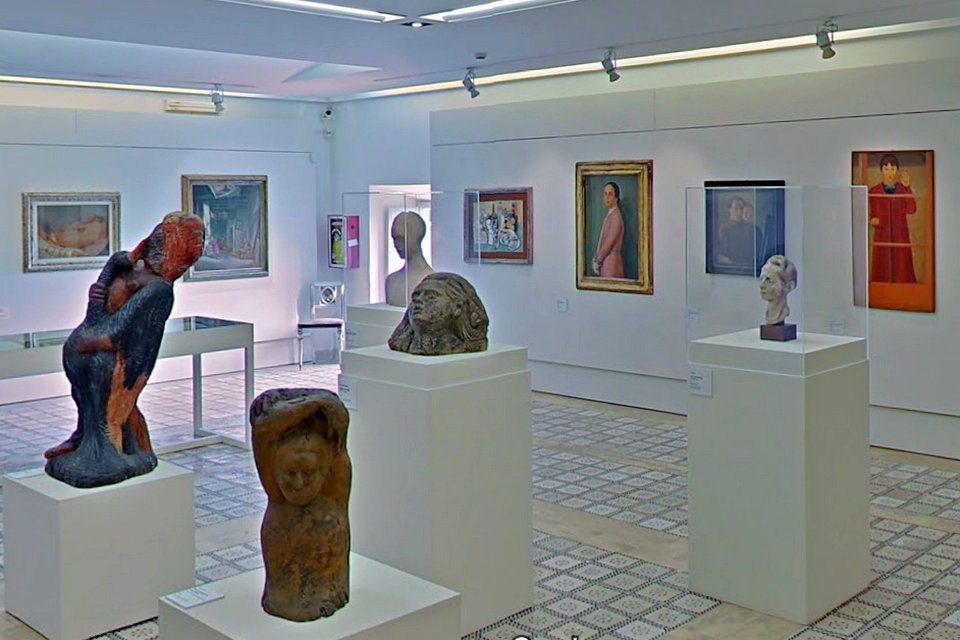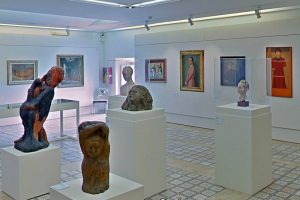The Museum, located on the top floor of the Casino Nobile, was open to the public in 2006 thanks to the support of Netta Vespignani, Miriam Mafai, Enzo Siciliano and Claudia Terenzi.
The works of art exposed in the rooms of the Museum offer a complete view on one of the most beautiful and interesting moments of the twentyfirst century arts, the figurative research in Rome between the first and the second world war.
From the characters of the magic Realism such as Antonio Donghi, Francesco Trombadori, Riccardo Francalancia, Ferruccio Ferrazzi, to that particular moment known as “Scuola di Via Cavour”, with Mario Mafai’s works of art, Antonietta Raphaël, the painters of the Thirties – Corrado Cagli, Giuseppe Capogrossi, Emanuele Cavalli, Roberto Melli, Guglielmo Janni- and those who, around the second world war, created a new “Realist language”, such as Alberto Ziveri, Fausto Pirandello, Renato Guttuso, the young Renzo Vespignani. To not forget some others who in sculpture such as Pericle Fazzini, Mirko Basaldella, Leoncillo Leonardi and of engraving such as Luigi Bartolini, a master of engravement.
The name “Roman School” is based its on some elements of determinant continuity: the relation with the city and its myth of antiquity, the ritual of “crafts”, the experimentation and, especially, a deep intolerance towards arts as the expression of a regime. Maybe as a reaction to the rhetorics, the works of art of these artists are an expression of the inner realities, of some looks full of anxiety, of a town in its hidden places or in those ones disappearing.
Among the most important masterpieces we can find a collection of portraits, among which Ferrazzi’s portrait (San Bernardino, 1943) and Roberto Melli’s one (1936) and some portraits such as, Ziveri’s one (painted by Guglielmo Janni, 1936), the landscapes (and the roman visions) Francalancia’s ones, Bartoli’s, Socrate’s, Vespignani’s portraits, the precious Francalancia’s still lives (Tea pot and caki, 1925) and Trombadori’s (Still life, around 1940).
Among the sculptures we can find the wonderful “Fuga da Sodoma” by Antonietta Raphaël (1935-1936), Dario Sabatello’s portrait by Fazzini (1934) and Furore by Mirko (1944).
The works of art in the Museum were given or loaned for use by Accademia Nazionale di Danza, Associazione Archivio della Scuola Romana, Luciana Bartolini, Giuseppe Bertolami, Giorgio Di Raimondo, Ilaria and Ninetta Ferrazzi, Fabiola Ferrazzi (heirs Castellet) Fondazione Carlo Levi, Elena Francalancia and Gustavo Francalancia (heir Marco Francalancia), Luciana Gentilini, Loredana Guarnieri, Giulia Mafai and Miriam Mafai (heirs Sara and Luciano Scalia), Carla Marchini, Paolo Nasso, Dora and Pierluigi Pirandello, Redini heirs, Claudia and Flaminia Terenzi, Donatella Trombadori, Netta and Marta Vespignani.
The Collection Ingrao Guina
The art of our post-war period in the collection of Francesco Ingrao and Ksenija Guina, donated by the heirs to Roma Capitale and permanently exhibited at the Museo della Scuola Romana in the Casino Nobile of Villa Torlonia.
The second world war art is represented in Francesco Ingrao and Ksenija Guina’s collection, given to the heirs by Roma Capitale and permanently exposed in the Museo della Scuola Romana in Casino Nobile di Villa Torlonia.
After Francesco Ingrao’s death, on 27 september 2003, and Ksenija’s art work, in february 2010, Mirjana Jovic, Ksenija’s sister, gave to Roma Capitale, thirtyfive works of art of the Ingrao – Guina collection. Part of the collection is in the Museo della Scuola Romana in Casino Nobile di Villa Torlonia from 2011.
As a symbol of an inner and amatorial collectionism, the art works here exposed are signed by some of the main artists of the Italian and International twentieth century: from Mario Mafai, Mirko Basaldella, Corrado Cagli, Renato Guttuso, Luigi Bartolini, Mino Maccari, Nino Bertoletti, all representatives of those masterpieces according the subjects and the languages of the Roman Schoool, to Alberto Burri, Giulio Turcato, Sebastian Matta, Pietro Consagra, the youngest protagonists of the artistic scene of the second world war.
In this precious collection you can find a particular aspect of the twentyfirst century which takes its origin from the passion for arts and the humanity towards the artist. An important heritage of that sinergy between the private and the public institution which allows to not loose and resume the history of the roman collectionism during the years of our postwar and its extraordinary and wide artistic season.
This precious collection reveals a particular aspect of twentieth-century patronage, which originates in the passion for art and human interest in the artist. An important heritage that the synergy between private donor and public institution allows today not to disperse and that summarizes in itself the history of Roman collecting in the years of our post-war period and its intense and extraordinary artistic season.
Casino Nobile or Palace
In 1796 Giovanni Torlonia purchased the Vigna Colonna, situated on the Via Nomentana, and commissioned Giuseppe Valadier to render the buildings and park more imposing.
Between 1802 and 1806 Valadier worked on the rebuilding and enlargement of the Casino Nobile, incorporating the old structure and adding to it with foreparts, porticoes and spacious terraces.
The core of Valadier’s version of the palace was the Salle à manger (Dining room), which is today known as the Ballroom. Illuminated by a single large semicircular window, the light was reflected by the mirrors that lined the other walls, artificially increasing the sources of light and creating the illusion of a large space.
The salon was decorated with elegant stucco hangings, paintings by Domenico Del Frate, and ten plaster low reliefs by Antonio Canova (some of which are today displayed in the “Bercerau” Room).
After Giovanni’s death, in 1832 his son Alessandro commissioned the painter and architect Giovan Battista Caretti to add further to the majesty and magnificence of the palace, and to decorate it with works by various talented artists and craftsmen.
To make the Palace more visible to those arriving from outside the city, the original simple facade designed and built by Valadier, which faced onto Via Nomentana, was given a grandiose pronaos. This, in turn, was endowed with a monumental loggia closed by a triangular pediment that enclosed a terracotta high relief of Bacchus returning triumphant from the Indies on a chariot drawn by tigers by Rinaldo Rinaldi.
The two small porticoed wings designed by Valadier were replaced by two porticoes with Doric columns that encircled the east and west sides of the Palace, forming semicircular projections at the four corners.
The severe and imposing monumental aspect of the building was acceded to by a wide steps leading up the Capitoline (Cordonata) that was at one time lined with colossal ancient statues.
But Caretti’s most extensive renovation was to the internal decorations which, more than the architecture, gave a completely new definition to the spatiality of the rooms.
The ground floor and piano nobile were used for official purposes, and their rooms were decorated throughout in varying styles and motifs that were perfectly in keeping with the referential taste that characterised the villa as a whole.
The service rooms and lodgings for the servants occupied the second floor and basement, and from the latter an underground gallery (still existing) led to the Casino dei Principi.
The basement also provided access to two bunkers built by Mussolini – one as a bomb shelter and the other as a gas shelter (temporarily closed to the public) and to an underground room discovered during recent restoration work.
This was built by Giovan Battista Caretti to resemble an Etruscan Tomb in both its construction and decorations, which were clearly inspired by the images found on Etruscan-Corinthian earthenware.
Museums of Villa Torlonia
The two Museums of Villa Torlonia are the Casino Nobile and the Casina delle civette and are part of the Museum System in the Municipality of Rome.
The Casino Nobile owes its appearance to the intervention, around 1802, by Giuseppe Valadier , followed, between 1835-40, by that of Giovan Battista Caretti who added the majestic pronaos of the facade.
Many painters worked on its decoration, such as Podesti and Coghetti , as well as sculptors and plasterers from the Thorvaldsen and Canova school.
Since opening to the public in 1997 as a museum space, the original Casina collection has been enriched with stained glass by the same authors and with drawings, sketches and preparatory cartoons.







